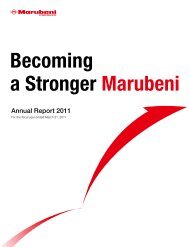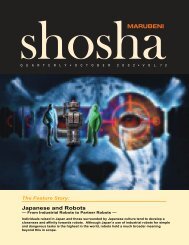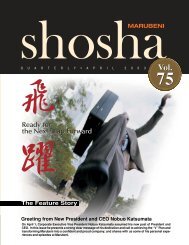Trust Recovery Growth Vitalization - Marubeni
Trust Recovery Growth Vitalization - Marubeni
Trust Recovery Growth Vitalization - Marubeni
Create successful ePaper yourself
Turn your PDF publications into a flip-book with our unique Google optimized e-Paper software.
Asset retirement obligations<br />
Effective for the year ended March 31, 2004, the Companies<br />
adopted Statement of Financial Accounting Standards No. 143,<br />
Accounting for Asset Retirement Obligations (SFAS 143). SFAS 143<br />
requires legal obligations associated with the retirement of long-lived<br />
assets to be recognized at their fair value at the time that the<br />
obligations are incurred. Upon initial recognition of a liability, that cost<br />
should be capitalized as part of the related long-lived asset and<br />
allocated to expense over the useful life of the asset. The adoption of<br />
SFAS 143 did not have a material impact on the Company’s financial<br />
positions and results of operations.<br />
Financial instruments with characteristics of both liabilities and<br />
equity<br />
Effective for the year ended March 31, 2004, the Companies<br />
adopted Statement of Financial Accounting Standards No. 150,<br />
Accounting for Certain Financial Instruments with Characteristics of<br />
both Liabilities and Equity (SFAS 150). SFAS 150 established<br />
standards for how an issuer classifies and measures certain financial<br />
instruments with characteristics of both liabilities and equity. The<br />
adoption of SFAS 150 did not have a material impact on the<br />
Company’s financial positions and results of operations.<br />
Revenue recognition and total volume of trading transactions<br />
The trading transactions undertaken by the Companies take many<br />
forms and consist of those in which the Companies act as principal<br />
and those in which the Companies act as agent. In agency transactions,<br />
payment for goods is made directly by the purchaser to the<br />
supplier. The Companies derive revenues from sales of goods,<br />
performance of services and commissions on trading transactions.<br />
Although the Companies legally act as a principal, certain<br />
transactions are reported net, as commissions, when the margins<br />
thereon are in substance considered commissions in accordance<br />
with FASB Emerging Issue Task Force Issue 99-19 Reporting<br />
Revenue Gross as a Principal versus Net as an Agent (EITF 99-19).<br />
When the Company is not the primary obligor and do not have<br />
general inventory risk, it generally presents the transaction net. The<br />
presentation may change according to changes in form or substance<br />
of transactions.<br />
The total volume of trading transactions, which is voluntarily<br />
disclosed in the statements of income, includes the sales value of all<br />
transactions in which the Companies participate, regardless of the<br />
form of such transaction, based on the practice of the Japanese<br />
trading companies.<br />
The Companies’ revenues and commissions are recognized when<br />
they are realized or realizable and earned. Revenues and commissions<br />
are realized or realizable and earned when the Companies have<br />
persuasive evidence of an arrangement, the goods have been<br />
delivered or the services have been rendered to the customer, the<br />
sales price is fixed or determinable and collection is reasonably<br />
assured.<br />
Sale of goods: In acting as a principal, revenue from the sale of<br />
goods is recognized when the delivery conditions are met. These<br />
conditions are considered to have been met when the goods are<br />
received by the customer or title to securities such as bills of lading<br />
are transferred to the customer. In addition, if required the implementation<br />
testing needs to be fully completed and any future<br />
obligations need to be perfunctory and not affect the customer’s final<br />
acceptance of the arrangement of revenue to be recognized.<br />
Performance of services: Commissions are recognized when the<br />
contracted services to the third-party customers are completed. In<br />
acting as agent, the Companies recognize commissions when<br />
contracted services are fully rendered to the customers.<br />
<strong>Marubeni</strong> Corporation 2005 76 / 77<br />
Long-term and large scale construction arrangements: Revenue<br />
is recognized by the completed-contract method unless reasonably<br />
dependable estimates of costs and extent of progress can be<br />
made, in which case revenue is recognized by the percentage-ofcompletion<br />
method.<br />
Shipping and handling costs are included in cost of revenues.<br />
Other expenses – net<br />
Other expenses – net includes losses incurred in liquidating<br />
subsidiaries and affiliated companies of ¥412 million ($3,850<br />
thousand), ¥6,549 million and ¥12,542 million for the years ended<br />
March 31, 2005, 2004 and 2003, respectively.<br />
Other expenses – net for the year ended March 31, 2005 also<br />
includes a loss on investment in and receivables from P.T. Chandra<br />
Asri of ¥21,347 million ($199,505 thousand).<br />
The aggregated amounts of losses on sales of loans, included in<br />
other expenses – net were ¥1,023 million and ¥1,790 million for the<br />
years ended March 31, 2004 and 2003, respectively. Such amount<br />
was not significant for the year ended March 31, 2005.<br />
Derivative instruments and hedging activities<br />
The Companies apply Statement of Financial Accounting Standard<br />
No. 133, Accounting for Derivative Instruments and Hedging<br />
Activities, as amended by SFAS138 and SFAS149.<br />
The Companies recognize all derivative instruments on the<br />
consolidated balance sheet at fair value. Derivatives that are not<br />
hedges must be adjusted to fair value through income. If the<br />
derivative is a hedge, depending on the nature of the hedge, changes<br />
in the fair value of derivatives will either be offset against the change<br />
in value of the hedged assets, liabilities, or firm commitments<br />
through earnings or recognized in other comprehensive income until<br />
the hedged item is recognized in earnings. The ineffective portion of<br />
the change in fair value of a hedge will be immediately recognized in<br />
earnings. For derivative and non-derivative financial instruments<br />
designated as hedging the foreign currency exposure of a net<br />
investment in foreign subsidiaries and affiliates, the gain or loss is<br />
reported in other comprehensive income as part of the cumulative<br />
translation adjustment to the extent the hedges are effective. Gains<br />
and losses related to the hedge ineffective portion and related to the<br />
portion of hedging instruments excluded from the assessment of<br />
hedge effectiveness are included in other expenses – net. The<br />
Companies expect to reclassify ¥323 million ($3,019 thousand) of net<br />
gain on derivative instruments from accumulated other comprehensive<br />
income to earnings during the 12 months ending March 31,<br />
2006, due to actual export and import transactions or receipts and<br />
payments of interest. The maximum length of time over which the<br />
Companies are hedging their exposure to the variability in future cash<br />
flows for forecasted transactions excluding those forecasted<br />
transactions related to the payments of variable interest on existing<br />
financial instruments is 24 months.<br />
Earnings per 100 shares of common stock<br />
The computation of basic earnings per 100 shares of common stock<br />
is based on the weighted average number of shares of common<br />
stock outstanding during the year. The computation of diluted<br />
earnings per 100 shares is based on the weighted average number<br />
of shares of common stock outstanding plus any potentially dilutive<br />
securities. For additional disclosures regarding convertible debentures<br />
and preferred stocks, refer to Notes 8, 11 and 12.


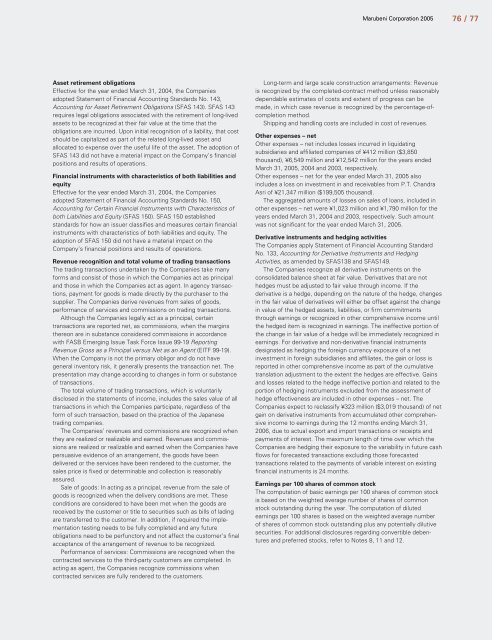
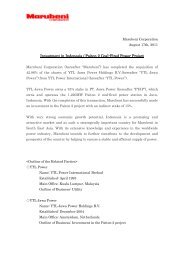
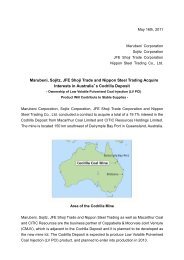
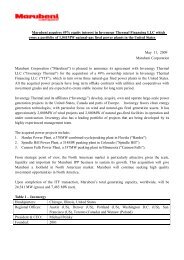
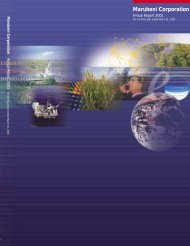
![[Chapter 2] Driving Growth: Expansion Under SG-12 - Marubeni](https://img.yumpu.com/4161147/1/190x248/chapter-2-driving-growth-expansion-under-sg-12-marubeni.jpg?quality=85)
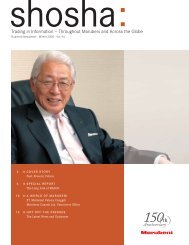

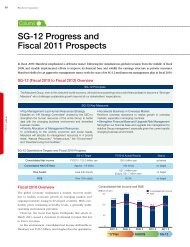
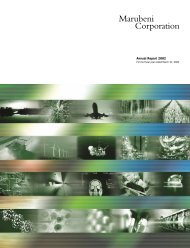
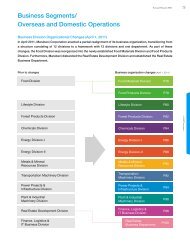
![[Chapter 4] Delivering Growth - Marubeni](https://img.yumpu.com/3464783/1/190x248/chapter-4-delivering-growth-marubeni.jpg?quality=85)
